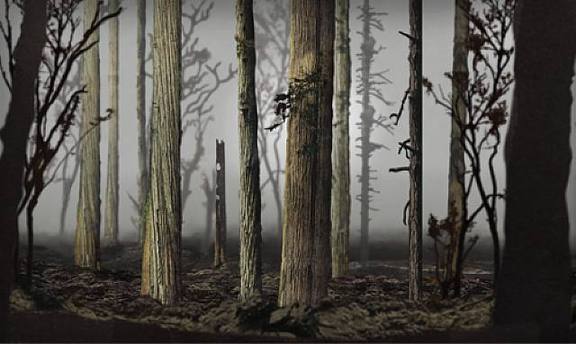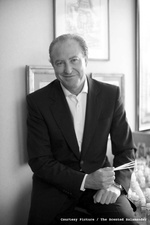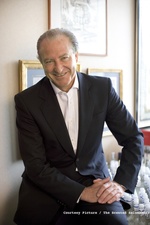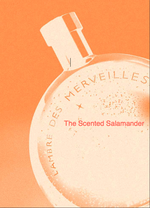Interview with Perfumer Crystelle Darchicourt of L'Atelier Bohême: A Perfume Must Make You Keel Over & Reflections On Masculinity {Perfume Q & A} - English Translation

Crystelle Darchicourt is the owner and perfumer of L'Artisan Bohême. We reviewed her fragrance, Fil de Soie (Silken Thread). The discussion started with questions on this masculine fragrance then addressed broader questions later on.
Marie-Hélène Wagner: What was your inspiration for creating a masculine perfume such as Fil de Soie (Silken Thread), which seems to me to be somewhat of an atypical perfume? The name too is rather feminine. What I mean by that is that one could have expected you to put more emphasis on masculine stereotypes, regarding both its name and olfactory codes.
Crystelle Darchicourt: Fil de Soie is part of the concept-perfumes. I have two ways of working with skin perfumes; perfumes of emotion have to do with olfactory experience, with preferences. On the other hand, concept-perfumes or of-the-mind have to do more with thought associations than smell associations. Fil de Soie relies no doubt on my unconscious, on the interpretation of masculine symbols. The point of departure is the idea of a stroll taken in the forest in which the sylvestrian god lives under the mythological form of the satyre. One then guesses the idea of the woodsy notes, the animal one, and the imprecise atmosphere conveyed by the aromatics.....
Fil de Soie is the translation of a feminine point of view on masculinity: attraction and distrust, some paradoxes and concordances. As you stress, the perfume remains vague, like the impression of a dream from which one emerges calm and at peace because it seems to us to be revelatory. This is why we are dealing with a silken thread and not the obvious appearance of the weft and maybe, why not, with Ariane’s thread (feminine attention allows men to shed the stereotypes in which they are often secluded), everyone is free to interpret it in its own way…
Moreover silk for a man is epitomized, in the spirit of the dandy, by the scarf: it is the symbol of both elegance and nonchalance on the part of someone who seduces without seemingly trying to.
The perfume is enriched with elements that borrow from feminine imagery. Incidentally, you did describe it as such in defining it as being powdery, amber-y, floral, and fruity, all at the same time. This ensemble of notes forms the humus of the forest, the feminine part of it. Trees are eminently masculine. This feminine part is also that of the dandy, who seduces thanks to his feminine side. (For me every man has a dandy side, mysterious and animal).
MHW: What was the idea behind your work on the leather note in Fil de Soie?
CD: Leather is the animal, corporeal part of man and of us human beings in general. It seemed unavoidable to me in my interpretation of masculinity. The leather in Fil de Soie offers a carnal base with a bonfire nuance that is reminiscent of embers. I imagine our animal part to be rather discreet but well anchored in us.
MHW: If it is not indiscreet, did you have some perfume references in mind when creating Fil De Soie?
CD: No, none at all. For concept-perfumes or perfumes of the mind, I have no references. Only associations of thoughts guide me. However, obviously, I do have them for emotional perfumes since they relate to my olfactory life experience. This is part of their charm.
MHW: Your perfumes seem to have, voluntarily, an indefinable aspect to them. They are slightly strange and a bit quirky. What do you do to create such an impression? Or to put it in yet other words, what are your aesthetic principles?
CD: The indefinable impression comes from the fact that I try to get closer to the natural aspect of a smell. I imagine perfumes like the clothes I love. They have to offer the impression of a ball of cotton or of silken and soft materials. Because softness is enveloping, warms you up and makes you smile…The discrepancy comes maybe from the treatment of the aroma in the perfume and its raw-material effect. The same flower can be interpreted as fresh and light like linen or warm and deep like cashmere. Everything depends on how one articulates one’s perfume and specifically the head and base notes. The heart being the obvious proposition, the floral side of the example afore-mentioned.
Since my aesthetic principles are based on my perception of the world, I would say that my perfumes are indeed all nuances and paradoxes. I like ambivalence, which strangely reassures me because it seems natural to me. Ambivalence or balance, it all depends on how you look at it.
MHW: Do you use only or mainly natural essences?
CD: All of my perfumes make use of naturals, because they cement the perfume, give it cachet. Some of my home fragrances are 100% natural. I do not use any animal ingredients. Otherwise I use everything that perfumery has to offer including synthetics in order to displace aestheticism, to be more creative thanks to a larger palette. I, of course, have a weakness for natural essences that are at times beautiful, at others, strange. They represent a concentrated version of nature that wants to be freed, to travel towards other skies, to be mixed with other fragrances.
MHW: How did you become a perfumer?
CD: I became a perfumer as I wished to ally art and science. Following scientific studies, I felt a void – there was another part of me that did not express itself. I have always wanted to work in a profession that would be both scientific and artistic. I practice pastel drawing and dance. I love music, theater and movies. Since one can’t do everything, one has to choose. As a result - I do not know how - I realized that perfumes did not make it into bottles by themselves. Better still they proceeded from chemistry and creativity. That was the glaring truth that I had been seeking out and I forged ahead. First I read some documentation, interned in olfaction then in the analysis of essential oils at the CNRS and interned as a perfume lab assistant. After my B.A., M.A., and D.U. in biochemistry I got into the school of perfumery in Versailles, ISIPCA. Then I was able to get a sense of big and small enterprises operate. My seventh professional experience is L’Atelier Bohême and I plan to wear this mark for a long time.
MHW: Could you please specify what you mean by your concept of “a perfume of emotion”? Does one of your creations correspond to this definition? What are your perfumes of reference, perfumes that inspire you in general or your favorite perfumes within his framework of reference?
CD: Emotional perfumes are based on memories, on my olfactory life experience. It is for me the opportunity of a re-writing of accords I love, of associations of smells or perfumes that have moved me deeply. For example for Hélianthe, the goal was to recreate the emotion that Guerlain Samsara provokes in me. The emotion is enveloping, powerful, very sensual. I have the impression of [seeing] the sun in the night! It is for me a perfume of the evening, a philter of love… It is a floral woodsy amber-y perfume.
The main accord that touches me is the marriage of ylang with sandalwood. I just started off with this association and I grafted onto it my preferences. There is a green note, which is rather juicy and sweet, and non-metallic. I did not either recapture the animalic aspect. After this simple point of departure, I built the perfume little by little following my olfactory inspiration. I let myself then be guided by my feelings and not by a thematic logic. In the end I created Hélianthe, which is fresher, greener, more joyous than my source of inspiration in the beginning. The midnight sun has transformed itself into a nascent sun, the one that carries hope! Hélianthe symbolizes the summer dawn!
Regarding my preferences, they are amber-y perfumes mixed with floral and woody notes as well as chypre perfumes. They have a sillage, a personality that touches me. They carry a strong olfactory message. I like that a perfume makes me keel over. It is not there to be clean or proper but to touch the unconscious, reveal the person. Perfume touches the sense,which is the most ancient and animal that is: olfaction. It is a sense that speaks the truth. I do not know of any olfactory mirage and that is what I like in perfumery: one either loves something or doesn’t. One just needs to let one’s heart speak!
MHW: Thank you so much for sharing your thoughts with us!
August 2007









